Japan tourism in August offers a vibrant mix of cultural festivals, stunning fireworks, and beautiful landscapes, but it also comes with unique challenges. SIXT.VN provides tailored travel solutions, from airport transfers to hotel bookings, ensuring a smooth and unforgettable experience. Consider SIXT.VN for planning your Japan trip, travel tips, and travel guide.
1. What Makes Japan Tourism in August Special?
Japan tourism in August is special because it is filled with vibrant summer festivals, breathtaking fireworks displays, and opportunities to explore stunning landscapes. During August, Japan comes alive with cultural celebrations.
1.1. Summer Festivals and Cultural Celebrations
August is a prime time to experience some of Japan’s most famous festivals:
- Awa Odori (Tokushima): This dance festival is one of the largest in Japan, featuring energetic performances and colorful costumes (Japan National Tourism Organization).
- Nebuta Matsuri (Aomori): Known for its giant illuminated floats paraded through the streets, this festival offers a visual spectacle (Aomori City Official Website).
- Tanabata Matsuri (Sendai): Celebrated with colorful streamers and decorations, this festival is a feast for the eyes (Sendai Tourism, Convention and International Association).
- Kanto Matsuri (Akita): Participants balance long bamboo poles with lanterns, showcasing impressive skill and tradition (Akita City Official Website).
These festivals offer an immersive experience into Japanese culture and traditions, providing unique memories for travelers.
1.2. Fireworks Displays
Japan’s fireworks displays are world-renowned for their artistry and scale:
- Nagaoka Fireworks Festival (Niigata): One of the three major fireworks festivals in Japan, featuring spectacular displays over several hours (Nagaoka City Official Website).
- Lake Suwa Fireworks Festival (Nagano): Held on Lake Suwa, this event offers a picturesque setting for stunning fireworks (Suwa City Official Website).
- Tokyo and Yokohama: Major cities also host impressive fireworks displays, drawing large crowds.
Attending these events allows visitors to witness the pinnacle of Japanese pyrotechnics, combining tradition and innovation.
1.3. Exploring Landscapes
August is ideal for escaping the summer heat by exploring Japan’s diverse landscapes:
- Hokkaido: Known for its national parks and cooler climate, Hokkaido offers hiking and nature exploration (Japan National Tourism Organization).
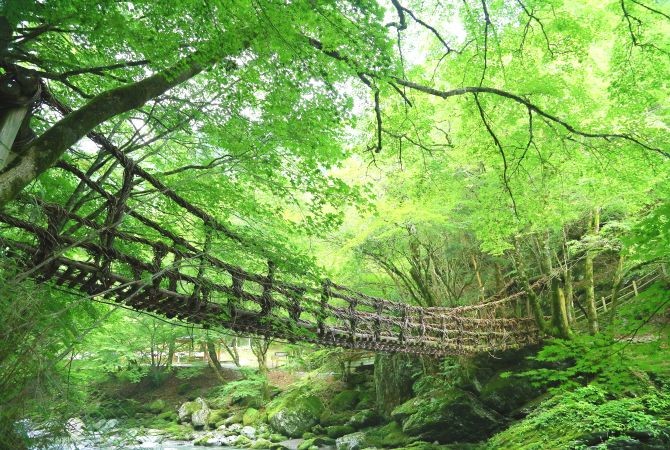 Hokkaido's vast landscapes for Japan tourism in August
Hokkaido's vast landscapes for Japan tourism in August
- Japan Alps: Central Honshu’s mountain range provides opportunities for hiking and enjoying cooler temperatures (Japan Alps Tourism Bureau).
- Okinawa: A beach holiday destination with clear waters and beautiful beaches (Okinawa Convention & Visitors Bureau).
- Kyushu: Offers less crowded beach resorts and surfing spots, like Aoshima Beach in Miyazaki (Kyushu Tourism Information).
- Amami Islands (Kagoshima): Known for their coastline and beaches, ideal for relaxation and exploration (Amami City Official Website).
These destinations provide a refreshing contrast to the urban heat, allowing travelers to experience Japan’s natural beauty.
1.4. Obon Festival
Obon is a significant cultural event in mid-August where families honor their ancestors:
- Returning Spirits: It’s believed that the spirits of deceased family members return to the realm of the living.
- Family Gatherings: Relatives gather at their family homes, enjoy community dance events, and take family outings.
- Kyoto’s Gozan Okuribi: On August 16, giant, flaming Chinese characters are lit on Kyoto’s hillsides to mark the end of Obon (Kyoto City Tourism Association).
Obon provides a unique cultural experience, allowing visitors to witness traditional customs and family-oriented celebrations.
1.5. Commemoration of Hiroshima Bombing
August 6 marks the anniversary of the atomic bombing of Hiroshima:
- Peace Memorial Ceremony: A moving ceremony is held at the Peace Memorial Park.
- Lantern Floating: Glowing lanterns are set adrift on the river, symbolizing remembrance and peace (Hiroshima Peace Memorial Museum).
Visiting Hiroshima during this time offers a poignant opportunity to reflect on history and pay respects to the victims.
2. What Are the Downsides of Visiting Japan in August?
While Japan tourism in August offers many attractions, potential downsides include high heat and humidity, the Obon holiday travel rush, and typhoon season. Planning ahead and being prepared can help mitigate these challenges.
2.1. High Heat and Humidity
August is one of the hottest and most humid months in Japan, especially in urban areas like Tokyo and Osaka.
- Health Risks: Heatstroke and exhaustion are common concerns, especially for those not used to the climate.
- Outdoor Activities: Extended outdoor activities can be challenging and require careful planning.
Visitors should stay hydrated, wear light clothing, and take frequent breaks in air-conditioned spaces.
2.2. Obon Holiday Travel Rush
The Obon holiday period (typically August 13-16) is a peak travel season in Japan, leading to crowded transportation and higher prices.
- Transportation: Trains, planes, and buses are often fully booked, and highways experience heavy congestion.
- Accommodation: Hotels and other accommodations can be more expensive and require booking well in advance.
Traveling outside the Obon period or staying in major cities, which are less crowded during this time, can help avoid the worst of the travel rush.
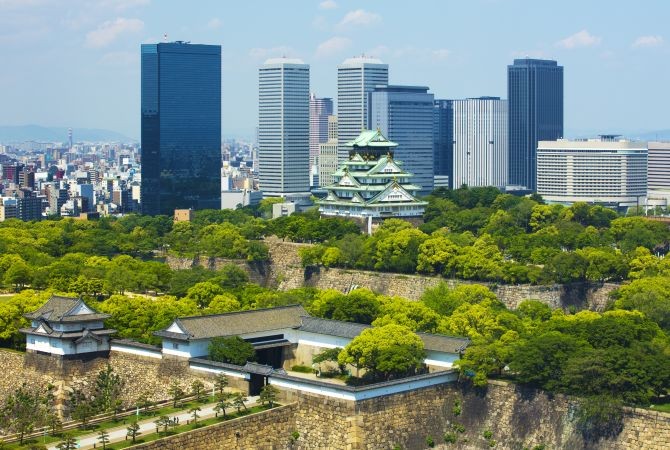 Less crowded streets in Osaka during Japan tourism in August
Less crowded streets in Osaka during Japan tourism in August
2.3. Typhoon Season
August falls within typhoon season in Japan, particularly affecting the southern regions.
- Travel Disruptions: Typhoons can cause flight cancellations, train delays, and disruptions to outdoor activities.
- Safety Concerns: Strong winds and heavy rain pose potential safety risks.
Travelers should monitor weather forecasts and be prepared to adjust their plans if necessary. Travel insurance that covers typhoon-related disruptions is also recommended.
2.4. Crowds at Popular Attractions
Many popular tourist destinations can be very crowded in August due to domestic and international tourists.
- Long Queues: Expect long lines at attractions, restaurants, and transportation hubs.
- Limited Space: Overcrowding can diminish the experience of visiting historical sites and natural landmarks.
Visiting less popular attractions or traveling during off-peak times of the day can help avoid some of the crowds.
2.5. Higher Prices
Due to peak season demand, prices for flights, accommodations, and other travel services tend to be higher in August.
- Flights: Airfares can be significantly more expensive compared to off-season months.
- Accommodation: Hotels and ryokans (traditional Japanese inns) often charge premium rates.
Booking well in advance and considering alternative accommodations, such as Airbnb, can help manage costs.
3. How to Plan a Trip to Japan in August?
Planning a trip to Japan in August requires careful consideration of the weather, crowds, and festivals. Booking accommodations and transportation in advance, staying hydrated, and monitoring weather forecasts are essential for a smooth trip.
3.1. Book Accommodations and Transportation in Advance
Given the high demand during August, it’s crucial to book accommodations and transportation as early as possible.
- Accommodations: Secure hotels, ryokans, or Airbnb options several months in advance to ensure availability and better prices.
- Transportation: Reserve train tickets (including Shinkansen bullet trains), flights, and highway buses well ahead of time, especially if traveling during the Obon holiday.
3.2. Stay Hydrated and Protect Yourself from the Sun
The high heat and humidity in August can lead to dehydration and sunburn, so taking precautions is essential.
- Hydration: Drink plenty of water throughout the day, even if you don’t feel thirsty. Carry a refillable water bottle.
- Sun Protection: Wear sunscreen, a hat, and sunglasses to protect yourself from the sun’s rays. Seek shade during peak hours (11 AM to 3 PM).
3.3. Monitor Weather Forecasts
Keep an eye on weather forecasts, especially if traveling during typhoon season.
- Weather Apps: Use reliable weather apps or websites to stay updated on potential typhoons or heavy rain.
- Flexible Itinerary: Be prepared to adjust your itinerary if necessary, and have backup plans for outdoor activities.
3.4. Pack Appropriately
Pack light, breathable clothing suitable for hot and humid weather.
- Clothing: Choose lightweight, loose-fitting clothes made from breathable fabrics like cotton or linen.
- Rain Gear: Bring a lightweight raincoat or umbrella in case of sudden showers.
3.5. Plan Around Festivals and Events
August is filled with festivals and events, so plan your itinerary to take advantage of these cultural experiences.
- Research: Look into local festivals and events happening in the areas you plan to visit.
- Reservations: Some festivals require advance ticket purchases or reservations, so check ahead of time.
3.6. Consider Travel Insurance
Travel insurance can provide coverage for unexpected events, such as flight cancellations due to typhoons or medical emergencies.
- Coverage: Ensure your policy covers trip cancellations, medical expenses, and lost or stolen belongings.
- Read the Fine Print: Understand the terms and conditions of your policy, including any exclusions or limitations.
3.7. Utilize Local Services and Amenities
Take advantage of local services and amenities to make your trip more comfortable.
- Convenience Stores: Stock up on water, snacks, and other essentials at convenience stores (konbini).
- Air-Conditioned Spaces: Take breaks in air-conditioned spaces like shopping malls, museums, or cafes to escape the heat.
- Public Transportation: Use Japan’s efficient public transportation system to get around, but be prepared for crowds during peak hours.
3.8. Learn Basic Japanese Phrases
Knowing a few basic Japanese phrases can enhance your travel experience and help you navigate daily situations.
- Greetings: Learn how to say hello (konnichiwa), thank you (arigato), and excuse me (sumimasen).
- Directions: Familiarize yourself with phrases for asking for directions or assistance.
4. What to See and Do in Japan in August?
Japan in August offers a diverse range of activities, from attending vibrant festivals and enjoying fireworks displays to exploring cooler highland regions and beautiful beaches. Whether you’re interested in culture, nature, or relaxation, there’s something for everyone.
4.1. Attend Summer Festivals
August is peak festival season in Japan, offering unique cultural experiences.
- Awa Odori (Tokushima): This energetic dance festival features thousands of performers in colorful costumes. It is worth the travel to experience.
- Nebuta Matsuri (Aomori): The giant illuminated floats paraded through the streets are a must-see.
 The Nebuta festival illuminated floats for Japan tourism in August
The Nebuta festival illuminated floats for Japan tourism in August
- Tanabata Matsuri (Sendai): This romantic star festival is celebrated with colorful streamers and decorations.
- Kanto Matsuri (Akita): Participants balance long bamboo poles with lanterns, showcasing impressive skill.
4.2. Watch Fireworks Displays
Japan’s fireworks displays are renowned for their artistry and scale.
- Nagaoka Fireworks Festival (Niigata): One of the three major fireworks festivals in Japan.
- Lake Suwa Fireworks Festival (Nagano): This picturesque lakeside setting enhances the stunning fireworks.
- Tokyo and Yokohama: Major cities also host high-profile fireworks displays.
4.3. Explore Highland Regions
Escape the summer heat by visiting cooler highland regions.
- Hokkaido: Known for its national parks and cooler climate, Hokkaido offers hiking and nature exploration.
- Japan Alps: This central Honshu mountain range provides opportunities for hiking and enjoying cooler temperatures.
- Mt. Daisen (Tottori): Hike to the summit for panoramic views and cooler air.
- Iya Valley (Shikoku): Explore shady ravines and lofty heights in Shikoku.
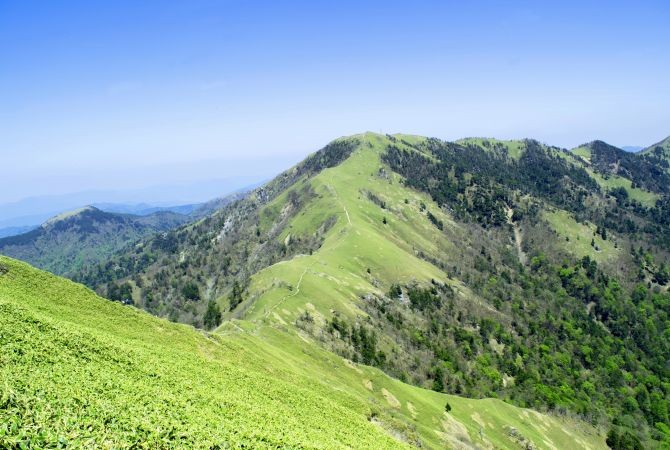 Shady valleys in Shikoku for Japan tourism in August
Shady valleys in Shikoku for Japan tourism in August
4.4. Relax on Beaches
Enjoy Japan’s beautiful beaches and coastal resorts.
- Okinawa: This is a premier beach holiday destination with clear waters and sandy shores.
- Kyushu: Offers less crowded beach resorts and surfing spots.
- Amami Islands (Kagoshima): Known for their coastline and beaches, ideal for relaxation and exploration.
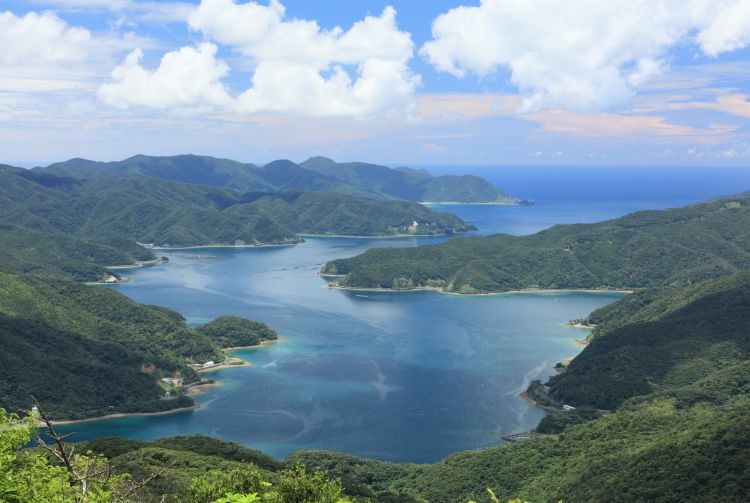 Amami Oshima coastlines for Japan tourism in August
Amami Oshima coastlines for Japan tourism in August
4.5. Visit Hiroshima Peace Memorial Park
Reflect on history and pay respects at the Hiroshima Peace Memorial Park.
- Peace Memorial Ceremony: Attend the moving ceremony on August 6.
- Lantern Floating: Observe the glowing lanterns set adrift on the river.
4.6. Experience Obon Festival
Participate in Obon festival activities and traditions.
- Family Gatherings: Witness families gathering to honor their ancestors.
- Kyoto’s Gozan Okuribi: Watch the giant, flaming Chinese characters light up Kyoto’s hillsides.
4.7. Enjoy Water Sports
Take advantage of Japan’s coastal regions for water sports.
- Surfing: Miyazaki in Kyushu is known for its surfing spots.
- Snorkeling and Diving: Explore the clear waters of Okinawa and the Amami Islands.
4.8. Explore Gardens and Parks
Visit Japanese gardens and parks for a tranquil escape from the summer heat.
- Kenrokuen Garden (Kanazawa): One of Japan’s three most beautiful landscape gardens.
- Shinjuku Gyoen National Garden (Tokyo): Offers diverse garden styles and peaceful settings.
4.9. Visit Museums and Art Galleries
Explore Japan’s rich cultural heritage by visiting museums and art galleries.
- Tokyo National Museum: Showcases Japanese art and artifacts.
- Ghibli Museum (Tokyo): Features the works of Studio Ghibli animation studio (reservations required).
- 21st Century Museum of Contemporary Art (Kanazawa): Presents modern and contemporary art exhibitions.
4.10. Indulge in Summer Cuisine
Savor seasonal Japanese dishes and treats.
- Cold Noodles (Somen, Soba): Refreshing noodle dishes served cold.
- Shaved Ice (Kakigori): Flavored shaved ice topped with sweet syrups and toppings.
- Grilled Eel (Unagi): A popular summer dish believed to boost stamina.
5. What Are Some Travel Tips for Japan in August?
Traveling to Japan in August requires some preparation due to the heat, humidity, and peak travel season. Essential tips include staying hydrated, booking accommodations and transportation in advance, monitoring weather forecasts, and being prepared for crowds.
5.1. Stay Hydrated and Avoid Heatstroke
The summer heat in Japan can be intense, so staying hydrated is crucial.
- Drink Plenty of Water: Carry a water bottle and refill it throughout the day.
- Electrolyte Drinks: Consider drinking electrolyte-enhanced beverages to replenish lost salts.
- Avoid Peak Hours: Limit outdoor activities during the hottest part of the day (11 AM to 3 PM).
5.2. Book Accommodations and Transportation Early
August is a popular travel month, so booking accommodations and transportation well in advance is essential.
- Hotels and Ryokans: Reserve your accommodations several months ahead to secure the best options and prices.
- Shinkansen Tickets: Book bullet train tickets in advance, especially if traveling during the Obon holiday.
- Domestic Flights: Reserve flights early to avoid higher fares and limited availability.
5.3. Be Prepared for Crowds
Expect crowds at popular tourist attractions, especially during festivals and holidays.
- Visit Early or Late: Arrive at attractions early in the morning or later in the afternoon to avoid peak crowds.
- Purchase Tickets Online: Buy tickets online in advance to skip the ticket lines.
- Consider Off-Peak Destinations: Explore lesser-known attractions to avoid overcrowding.
5.4. Pack Light and Wear Breathable Clothing
Pack light, breathable clothing suitable for hot and humid weather.
- Light Fabrics: Choose lightweight fabrics like cotton, linen, or moisture-wicking materials.
- Sun Protection: Pack a hat, sunglasses, and sunscreen to protect yourself from the sun.
- Comfortable Shoes: Wear comfortable walking shoes for exploring cities and attractions.
5.5. Learn Basic Japanese Phrases
Knowing a few basic Japanese phrases can enhance your travel experience and help you navigate daily situations.
- Greetings: Learn how to say hello (konnichiwa), thank you (arigato), and excuse me (sumimasen).
- Directions: Familiarize yourself with phrases for asking for directions or assistance.
- Ordering Food: Know how to order food and ask about ingredients or allergies.
5.6. Respect Local Customs and Etiquette
Be mindful of Japanese customs and etiquette to ensure a smooth and respectful travel experience.
- Remove Shoes Indoors: Take off your shoes when entering homes, temples, and some traditional restaurants.
- Avoid Loud Talking on Trains: Refrain from talking loudly on trains and public transportation.
- Tipping is Not Customary: Tipping is not expected in Japan, and attempting to tip may cause confusion or embarrassment.
5.7. Stay Connected with a Pocket Wi-Fi or SIM Card
Having internet access can be helpful for navigation, translation, and staying connected with family and friends.
- Pocket Wi-Fi: Rent a pocket Wi-Fi device for convenient internet access throughout your trip.
- SIM Card: Purchase a local SIM card for your smartphone to access data and make local calls.
5.8. Carry Cash
While credit cards are accepted in many establishments, it’s still a good idea to carry cash for smaller shops, restaurants, and temples.
- Withdraw Cash at ATMs: Use ATMs at convenience stores (such as 7-Eleven) or post offices to withdraw cash.
- Inform Your Bank: Notify your bank of your travel plans to avoid any issues with your credit or debit cards.
5.9. Monitor Weather Forecasts and Be Prepared for Typhoons
August is typhoon season in Japan, so it’s essential to monitor weather forecasts and be prepared for potential disruptions.
- Weather Apps: Use reliable weather apps or websites to stay updated on potential typhoons or heavy rain.
- Travel Insurance: Purchase travel insurance that covers trip cancellations, medical expenses, and lost or stolen belongings.
- Flexible Itinerary: Be prepared to adjust your itinerary if necessary, and have backup plans for outdoor activities.
5.10. Utilize Local Services and Amenities
Take advantage of local services and amenities to make your trip more comfortable.
- Convenience Stores: Stock up on water, snacks, and other essentials at convenience stores (konbini).
- Tourist Information Centers: Visit tourist information centers for maps, brochures, and helpful advice.
- Public Transportation: Use Japan’s efficient public transportation system to get around, but be prepared for crowds during peak hours.
6. What Are Some Less Crowded Destinations in Japan in August?
If you’re looking to avoid the crowds during Japan tourism in August, consider visiting less popular destinations that offer unique experiences and stunning scenery without the hustle and bustle.
6.1. Shikoku
Shikoku is the smallest of Japan’s four main islands and offers a tranquil escape from the crowds.
- Iya Valley: Explore the remote Iya Valley with its vine bridges and stunning natural beauty.
- Matsuyama Castle: Visit one of Japan’s twelve original castles, offering panoramic views of the city.
- Shikoku Pilgrimage: Follow a portion of the 88-temple pilgrimage route, visiting serene temples and scenic landscapes.
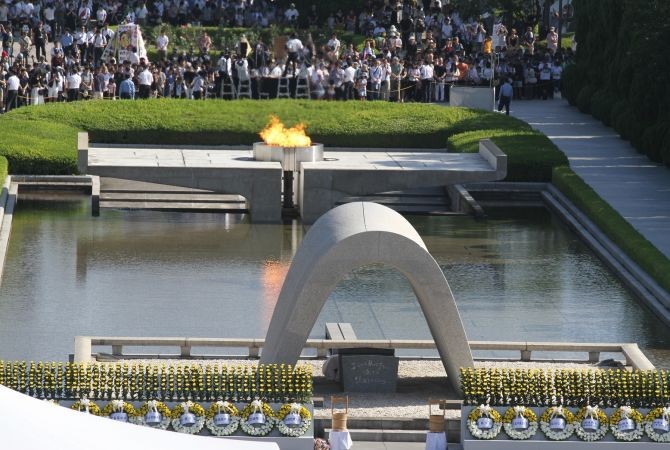 The original castles, such as Matsuyama Castle, for Japan tourism in August
The original castles, such as Matsuyama Castle, for Japan tourism in August
6.2. San’in Region
The San’in region, located along the Sea of Japan coast, offers rugged coastlines, historic towns, and fewer tourists.
- Tottori Sand Dunes: Explore Japan’s largest sand dunes, offering unique landscapes and activities like sandboarding.
- Matsue Castle: Visit another of Japan’s original castles, surrounded by scenic moats and gardens.
- Izumo Taisha Shrine: One of Japan’s oldest and most important Shinto shrines.
6.3. Tohoku Region (Outside of Festival Dates)
While the Tohoku region is famous for its summer festivals, visiting outside of those specific dates can offer a more peaceful experience.
- Lake Tazawa (Akita): Enjoy the stunning natural beauty of Japan’s deepest lake.
- Hirosaki Castle (Aomori): Visit a beautiful castle with well-preserved grounds and gardens.
- Yamadera Temple (Yamagata): Climb the steps to this mountaintop temple for breathtaking views.
6.4. Kyushu (Outside of Major Cities)
Explore the less crowded areas of Kyushu, focusing on natural beauty and smaller towns.
- Takachiho Gorge (Miyazaki): Paddle a boat through this stunning gorge with towering cliffs and waterfalls.
- Yakushima Island (Kagoshima): Hike through ancient cedar forests on this UNESCO World Heritage site.
- Beppu Onsen (Oita): Experience a variety of hot springs in this famous onsen town.
6.5. Inland Sea Islands
The Seto Inland Sea is dotted with numerous islands, offering a tranquil escape and unique cultural experiences.
- Naoshima: Known for its contemporary art museums and installations.
- Teshima: Explore another art island with unique museums and scenic landscapes.
- Shodoshima: Famous for its olive groves, beaches, and hiking trails.
6.6. Kiso Valley
The Kiso Valley in Nagano Prefecture offers a glimpse into traditional Japan with well-preserved post towns.
- Tsumago: Walk through this beautifully preserved post town with traditional buildings and scenic landscapes.
- Magome: Another charming post town connected to Tsumago by a scenic hiking trail.
- Narai: The longest post town in the Kiso Valley, with well-preserved Edo-era buildings.
7. How Can SIXT.VN Enhance Your Japan Tourism in August?
SIXT.VN offers a range of services designed to make your Japan tourism in August more convenient, comfortable, and enjoyable. From airport transfers to hotel bookings and curated tours, SIXT.VN can handle all the details so you can focus on creating unforgettable memories.
7.1. Airport Transfers
Start your trip off right with a seamless airport transfer from SIXT.VN.
- Convenient Pick-Up: Our drivers will meet you at the airport and take you directly to your hotel or other destination.
- Comfortable Vehicles: Enjoy a comfortable ride in our well-maintained vehicles, equipped with air conditioning to beat the summer heat.
- Professional Service: Our experienced drivers are knowledgeable about the local area and can provide helpful tips and recommendations.
Address: 260 Cau Giay, Hanoi, Vietnam. Hotline/Whatsapp: +84 986 244 358. Website: SIXT.VN.
7.2. Hotel Bookings
SIXT.VN offers a wide selection of hotels to suit every budget and preference.
- Variety of Options: Choose from luxury hotels, business hotels, ryokans (traditional Japanese inns), and budget-friendly accommodations.
- Prime Locations: We offer hotels in convenient locations near popular attractions and transportation hubs.
- Competitive Rates: Take advantage of our competitive rates and special deals to save money on your accommodations.
7.3. Tailored Tour Packages
Let SIXT.VN create a customized tour package to suit your interests and schedule.
- Cultural Tours: Explore Japan’s rich cultural heritage with guided tours of temples, shrines, and historical sites.
- Nature Tours: Discover Japan’s natural beauty with hiking tours, scenic drives, and visits to national parks.
- Festival Packages: Experience the excitement of Japan’s summer festivals with our specially designed festival packages.
7.4. Local Transportation Assistance
SIXT.VN can assist with local transportation arrangements to help you get around Japan with ease.
- Japan Rail Pass: We can help you purchase a Japan Rail Pass, which offers unlimited travel on JR trains, including Shinkansen bullet trains.
- Private Car Service: Hire a private car and driver for a more personalized and flexible transportation option.
- Rental Cars: We can arrange for rental cars if you prefer to explore Japan at your own pace.
7.5. Language and Cultural Support
Overcome language barriers and gain a deeper understanding of Japanese culture with SIXT.VN.
- Multilingual Staff: Our staff can assist you in English, Vietnamese, and other languages.
- Translation Services: We offer translation services to help you communicate with locals and navigate daily situations.
- Cultural Insights: Our guides can provide valuable insights into Japanese customs, etiquette, and traditions.
7.6. 24/7 Customer Support
Enjoy peace of mind knowing that SIXT.VN is available to assist you 24/7.
- Emergency Assistance: We provide emergency assistance in case of unexpected events or emergencies.
- Travel Advice: Our travel experts can offer helpful advice and recommendations to enhance your trip.
- Problem Resolution: We are committed to resolving any issues or concerns that may arise during your trip.
7.7. Recommendations for Destinations in August
Discover the best places to visit in Japan in August with SIXT.VN’s expert recommendations.
- Festival Hotspots: We can guide you to the best summer festivals, such as Awa Odori in Tokushima and Nebuta Matsuri in Aomori.
- Cool Escapes: Escape the heat by visiting highland regions like Hokkaido and the Japan Alps.
- Beach Getaways: Relax on the beautiful beaches of Okinawa and Kyushu.
7.8. Itinerary Planning
Let SIXT.VN help you create a customized itinerary that maximizes your time and budget.
- Personalized Itineraries: We can design an itinerary based on your interests, preferences, and travel style.
- Efficient Routing: We can help you plan the most efficient routes to minimize travel time and maximize sightseeing opportunities.
- Flexibility: We can adjust your itinerary as needed to accommodate unexpected events or changes in your plans.
7.9. Budget Management
SIXT.VN can help you manage your budget and find affordable travel options.
- Cost-Effective Recommendations: We can suggest cost-effective accommodations, transportation, and activities.
- Package Deals: Take advantage of our package deals that combine accommodations, tours, and transportation for savings.
- Price Comparisons: We can help you compare prices and find the best deals on flights, hotels, and other travel services.
7.10. Cultural Immersion
Immerse yourself in Japanese culture with SIXT.VN’s cultural experiences.
- Tea Ceremony: Participate in a traditional tea ceremony and learn about the art of tea preparation.
- Kimono Experience: Dress up in a traditional kimono and stroll through historic districts.
- Cooking Classes: Learn how to prepare Japanese dishes and savor the flavors of Japan.
By utilizing the services of SIXT.VN, you can ensure a seamless, memorable, and culturally enriching Japan tourism in August, tailored to your specific needs and preferences.
8. What are the Travel Requirements for Japan in August?
Traveling to Japan in August requires understanding and adhering to the current travel requirements, which may include visa regulations, passport validity, vaccination status, and any COVID-19 related protocols.
8.1. Visa Requirements
Check whether you need a visa to enter Japan based on your nationality.
- Visa-Exempt Countries: Many countries have visa-exemption agreements with Japan for short-term tourism (typically up to 90 days).
- Visa Application: If you require a visa, apply well in advance at the nearest Japanese embassy or consulate.
8.2. Passport Validity
Ensure your passport is valid for the duration of your stay in Japan.
- Validity Period: It is generally recommended that your passport be valid for at least six months beyond your intended stay.
- Blank Pages: Make sure your passport has enough blank pages for entry and exit stamps.
8.3. COVID-19 Related Requirements
Stay updated on the latest COVID-19 related travel requirements, which may include vaccination status, pre-departure testing, and quarantine measures.
- Vaccination Status: Check if proof of vaccination is required for entry or to avoid quarantine.
- Pre-Departure Testing: Determine if a negative COVID-19 test is required before departure and which type of test is accepted.
- Quarantine Measures: Understand if quarantine is required upon arrival and for how long.
8.4. Customs Regulations
Familiarize yourself with Japan’s customs regulations regarding items you can bring into the country.
- Prohibited Items: Be aware of items that are prohibited, such as certain types of food, weapons, and drugs.
- Restricted Items: Know the regulations for restricted items, such as alcohol and tobacco, including any limits on quantities.
8.5. Travel Insurance
Consider purchasing travel insurance that covers medical expenses, trip cancellations, and other unexpected events.
- Medical Coverage: Ensure your policy covers medical treatment in Japan, including COVID-19 related expenses.
- Trip Cancellation: Check if your policy covers trip cancellations due to illness, travel restrictions, or other unforeseen circumstances.
8.6. Health Recommendations
Consult with your doctor regarding any necessary vaccinations or health precautions for traveling to Japan.
- Vaccinations: Ensure you are up-to-date on routine vaccinations and consider any recommended vaccines for Japan.
- Medications: Bring any necessary prescription medications with you and carry a copy of your prescription.
8.7. Registration with Your Embassy
Consider registering your travel plans with your embassy or consulate in Japan.
- Emergency Contact: This allows your embassy to contact you in case of an emergency.
- Travel Advisories: You can receive updates on travel advisories or safety concerns in Japan.
8.8. Immigration Card
You will need to fill out an immigration card upon arrival in Japan.
- Accurate Information: Provide accurate information on the card, including your name, passport number, and address in Japan.
- Arrival Information: Include your flight number and purpose of visit.
8.9. Quarantine App (If Applicable)
If required, download and register with the necessary quarantine app for health monitoring.
- App Registration: Follow the instructions to register your information and comply with any health monitoring requirements.
8.10. Adherence to Local Laws and Regulations
Be aware of and adhere to local laws and regulations during your stay in Japan.
- Public Behavior: Respect public behavior norms, such as refraining from loud talking on trains and avoiding littering.
- Drug Laws: Be aware of Japan’s strict drug laws and avoid possession or use of illegal substances.
Staying informed and prepared regarding these travel requirements will help ensure a smooth and trouble-free trip to Japan in August.
9. What Foods Should You Try in Japan in August?
Japan in August offers a variety of seasonal foods that are perfect for the summer heat. From refreshing cold noodles to flavorful grilled eel, there’s plenty to savor.
9.1. Somen Noodles
Somen noodles are thin, white wheat noodles that are typically served cold with a dipping sauce.
- Nagashi Somen: Enjoy nagashi somen, where the noodles flow down a bamboo chute, and you catch them with chopsticks.
- Dipping Sauce: The dipping sauce is usually made from soy sauce, mirin, and dashi, with added condiments like ginger and green onions.
9.2. Hiyashi Chuka
Hiyashi chuka is a cold ramen dish with a variety of toppings, perfect for a light and refreshing meal.
- Toppings: Common toppings include sliced ham, cucumber, tomatoes, shredded egg, and pickled ginger.
- Sesame Dressing: The dish is typically dressed with a sesame-based sauce.
9.3. Kakigori
Kakigori is a shaved ice dessert topped with flavored syrups and condensed milk.
- Flavors: Popular flavors include strawberry, melon, and matcha.
- Toppings: Additional toppings can include sweet beans, mochi, and ice cream.
9.4. Unagi (Grilled Eel)
Unagi is grilled eel that is often eaten in the summer to boost stamina.
- Unadon: Unagi is served over rice in a dish called unadon, topped with a sweet and savory sauce.
- Health Benefits: Unagi is rich in vitamins and nutrients, believed to combat summer fatigue.
9.5. Edamame
Edamame are steamed green soybeans that are often served as a snack or appetizer.
- Preparation: The soybeans are steamed or boiled and sprinkled with salt.
- Enjoyment: Eat them straight from the pod by squeezing the beans into your mouth.
9.6. Watermelon
Watermelon is a refreshing and hydrating fruit that is widely available in August.
- Suika Wari: Enjoy suika wari, a traditional game where participants try to break a watermelon with a stick while blindfolded.
9.7. Hamo (Dagger-Tooth Conger Eel)
Hamo is a type of eel that is popular in Kyoto cuisine during the summer months.
- Preparation: Hamo is often grilled or used in soups, known for its delicate flavor.
9.8. Cold Tofu
Cold tofu is a simple and refreshing dish that is often served with soy sauce and condiments.
- Condiments: Common condiments include ginger, green onions, and bonito flakes.



